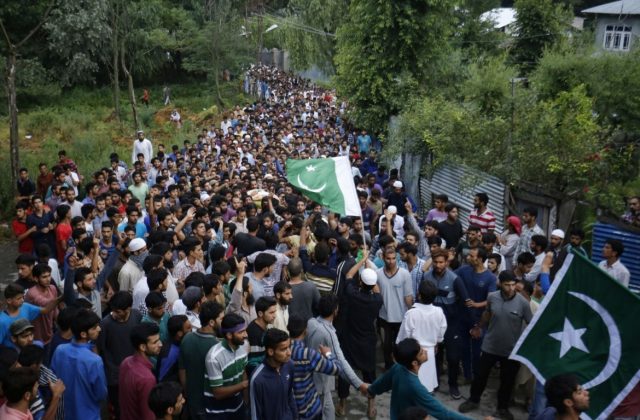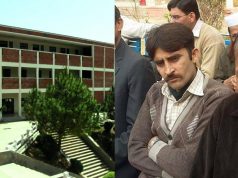Kashmir Solidarity Day, or what known to many as simply “Kashmir Day” is an annual national holiday in Pakistan that observes our state’s support with the people of Indian-administered Kashmir (Indian occupied Kashmir) and to pay homage to Kashmiris who have died in the conflict. Some people take this day as nothing more than a holiday to enjoy their day off while some take out solidarity rallies in the capital and across the country as a “protest” against what they call as “brutality of the Indian occupied forces”. These crises, unrest, violence, and conflict in Kashmir valley are not new. Anyone growing up in the 80’s or 90’s would clearly remember the regular PTV coverage about the conflict in Kashmir followed by some patriotic songs which were on broadcast in an attempt to extend solidarity with the oppressed Kashmiri population.
The conflict has been going on for decades. It escalated into an armed conflict in the late 80s when Kashmiris rebelled against the Indian rule. The long-lasting issue of Kashmir conflict, to this day, not only stands as the biggest problem between the two neighboring countries but even serves as the backbone of bilateral relations that these two countries share. Despite that, the complexity of the issue has almost never been understood by the masses in both countries. This is why the oversimplification of the issue – where one side always portrays the other to be the sole reason behind the chaos in the valley as well as the biggest hurdle in bringing peace and stability in the region – leaves many questions unanswered. There’s a lot that people in both countries are not aware of. There are several documented “assurances” and “promises” that were never fulfilled, The story of betrayal with the hopes of Kashmiri people is something both Indians and Pakistanis need to know to at least understand if not solve the long-lasting conflict. To understand the basics, we’d have to go 70 years back to find out the roots of the conflict that has always been the burning question between relations of India and Pakistan.
On 26th October 1947, soon after Maharaja Hari Singh, the last ruling Maharaja of the princely state of Jammu and Kashmir signed the instrument of accession to India and requested Delhi for military assistance to fight the tribal forces of Pakistan that invaded Kashmir to support the local Muslim population that revolted against the Maharaja in the aftermath of Muslim population massacre in the princely state, the Indian army officially intervened in Kashmir . The same day, Indian Prime Minister Pandit Jawaharlal Nehru sent a telegram to the Prime Minister of Pakistan, Liaquat Ali Khan, saying:
“I should like to make it clear that the question of aiding Kashmir in this emergency is not designed in any way to influence the state to accede to India. Our view which we have repeatedly made public is that the question of accession in any disputed territory or state must be decided in accordance with wishes of people and we adhere to this view.”
(Telegram 402 Primin-2227 dated 27th October 1947 to PM of Pakistan repeating telegram addressed to PM of UK)
The Indian intervention in Kashmir led to full-fledged war between the two newly formed states that went on for a year. After fighting a year-long war, a cease-fire was agreed to by both countries, which came into effect. The terms of the cease-fire required Pakistan to withdraw its forces, both regular and irregular, while allowing India to maintain the minimum strength of its forces in the state to preserve law and order. On compliance of these conditions, a plebiscite was to be held to determine the future of the territory.
The Kashmir resolution, formally known as United Nations Security Council Resolution 47, which was adopted on April 21, 1948 states:
“Noting with satisfaction that both India and Pakistan desire that the question of the accession of Jammu and Kashmir to India or Pakistan should be decided through the democratic method of a free and impartial plebiscite, Considering that the continuation of the dispute is likely to endanger international peace and security, Reaffirms its resolution 38 (1948) of 17 January 1948.
(The Resolution) Recommends to the Governments of India and Pakistan the following measures as those which in the opinion of the Council and appropriate to bring about a cessation of the lighting and to create proper conditions for a free and impartial plebiscite to decide whether the State of Jammu and Kashmir is to accede to India or Pakistan.
- The Government of Pakistan should undertake to use its best endeavors:
To secure the withdrawal from the State of Jammu and Kashmir of tribesmen and
Pakistani nationals not normally resident therein who have entered the State for the purposes of fighting, and to prevent any intrusion into the State of such elements and any furnishing of material aid to those fighting in the State.
- The Government of India should:
When it is established to the satisfaction of the Commission set up in accordance with the Council’s Resolution 39 (1948) that the tribesmen are withdrawing and that arrangements for the cessation of the fighting have become effective, put into operation in consultation with the Commission a plan for withdrawing their own forces from Jammu and Kashmir and reducing them progressively to the minimum strength required for the support of the civil power in the maintenance of law and order.’’
Since the adoption of this resolution, both countries claim to solve Kashmir conflict peacefully. Even though Pakistan once attempted to gain control over Indian held Kashmir through “Operation Gibraltar” – which resulted in a major failure as India retaliated on the International border which led to Indo-Pak war of 1965 – the state of Pakistan repeatedly urges to solve Kashmir conflict as per United Nations Security Council Resolution 47. However, both states seem in no mood to act upon the resolution because the very first clause of the resolution that talks about demilitarization of Jammu & Kashmir directing Pakistan to secure the withdrawal of its forces from the State of Jammu and Kashmir hasn’t been fulfilled by Pakistan even after 65 years. Acting upon the first clause of resolution means Pakistan pulling out of its Kashmir and going back to 1947 borders, something that is almost impossible for Pakistan to do now.
The Indian state, on the other hand, initially under the leadership of Prime Minister Pandit Jawaharlal Nehru promised plebiscite to people of Jammu and Kashmir in 1947. Not only did he send telegrams to his Pakistani counterpart, Prime Minister Liaqat Ali Khan, proposing to make a joint request to U.N.O. to undertake a plebiscite in Kashmir at the earliest possible date, he also spoke about solving the conflict in accordance with the wishes of people of Jammu & Kashmir even in the Indian parliament.
“We had given our pledge to the people of Kashmir, and subsequently to the United Nations; we stood by it and we stand by it today. Let the people of Kashmir decide.”
(Statement in the Indian Parliament, 31 March 1955)
Things, however, are different now. Currently, Indian state seems highly unlikely to support any sort of plebiscite given the fact that back in the 1940s and 1950s when PM Nehru talked about a plebiscite, Kashmir had quite a considerable population of Hindus, Buddhists, and even Sikhs. However, things changed in the late 1980s and throughout the 1990s.
Due to the success of mujahideen in Afghanistan against Soviets, Pakistan decided to apply the same model in Kashmir. Arming the separatist guerrillas and militant groups, the armed Islamic rebellion in Kashmir backed by Pakistan started in the late 80s and the local Hindu Kashmiri population became the first target of the insurgents. This resulted in a mass exodus and ethnic cleansing of Kashmiri Hindu Pandits who were either killed by Insurgents or were simply forced to flee. Indian state responded by deploying massive force in the valley, launching a crackdown on the militant outfits.

Since then, the vicious cycle of armed insurgency => Encounter of militants => Public protests => Use of force by security forces on protesters => Imposition of curfew – keeps repeating itself. This vicious cycle produced Burhan Mazzafar Wani, the 22-year-old commander of Kashmiri insurgent group Hizbul Mujahedeen who was killed in a gun battle with security forces in 2016. Wani reportedly joined the armed struggle after his brother Khalid was killed by the Indian security forces. The more the violence against civilians, the more Wanis will be produced and the brutal cycle will unfortunately continue. With the aim of curbing separatist movement, Indian Armed forces and Jammu & Kashmir police have been involved in atrocities ranging from mass killings, enforced disappearances, torture, rape and sexual abuse. Security forces have been accused and held accountable for committing severe human rights abuses against Kashmiri civilians. These crimes must be condemned openly. Using violence against Kashmiri civilians is doing nothing but suppressing the voice of Kashmiri citizens. With ethnic cleansing of Hindus, current demographics of Kashmir have changed to such an extent that result of any plebiscite, or referendum would be simply unacceptable to India as the vote bank of Hindus in Jammu and few Buddhists in Ladakh will never be enough to counter those of separatists and that’s something India wouldn’t want to witness happening in territory it calls its “integral part.”
What Indian people need to understand is that even though the Pakistani state and the Pakistan based Islamist groups in the likes of Lashkar e Taiba and Hizb ul Mujahiden take full credit and responsibility for supporting, arming and financing the Kashmiri freedom movement, it is impossible for the militant groups alone to influence thousands of Kashmiri youth to take up arms against their state only by supplying arms and money, there are always some unfair state policies which make local population accept foreign support. Even if the state of Pakistan is pouring billions of Dollars in Kashmir, it is still humanely impossible to flood the streets of Srinagar with thousands of men, women, and children against Indian rule without that very local Kashmiri popular holding grievances or anti-state sentiments.
These grievances exist because, at some point in time, the state has been unfair to these people, these grievances need to be addressed and solved and they can never be solved through military crackdowns, forced disappearances, curfews, rapes, pellet guns or by simply painting indigenous people as ”Anti nationals” ”terrorists” or ”Pakistani agents.”
No matter on what side of the conflict you want to align yourself, as a human, we can at least amidst that no amount of nationalism can justify human rights violations and no amount of patriotism is worth human lives.
In this war between two regional rivals, where one calls Kashmir its “Sheh ragg” (Aorta) while the other refers to it as its “Atoot Ang” (Infrangible) it is the average peaceful citizen of Kashmir who has to go through regular interrogations, deal with draconian laws like Armed Forces Special Powers Act (AFSPA), bear the routine checking and search, witness long curfews and pay the price of being the citizen of Kashmir valley because,
‘’When two elephants fight, it is only the grass that gets crushed.’’






